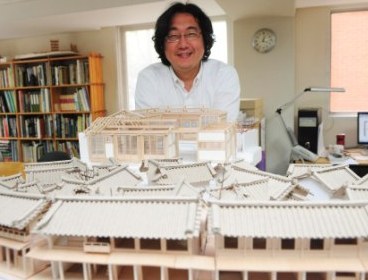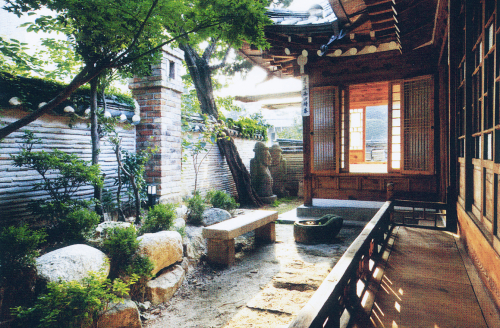2011년 5월 5일자 코리아 헤럴드에 실린 기사 입니다.
한옥에 대한 신화를 타파하는 건축가
조정구, 전통을 존중하며 현대적으로 한옥을 이야기하다
경복궁의 서쪽과 창덕궁의 동쪽 사이에 포근하게 자리한 북촌은 시간이 멈춰있는 듯한 보석 같은 동네이다.
무수한 골목과 한옥 또는 한국 전통 가옥이 백여 년 동안 계속 자리하고 있다는 것은 무계획적인 재개발과 고층빌딩에 대한 열망이 가득 찬 거대 도시에서는 이례적인 일이다.
사실 북촌의 한옥을 보존하기 위한 서울시의 노력이 없었다면 이 독특한 지역은 영원히 사라졌을 것이다. 1983년, 한옥 보존 지역으로 지정하며 시작된 북촌의 한옥을 보존하기 위한 프로젝트는 30여 년 동안 지속되고 있다. 이러한 노력으로 대부분의 거주 지역에 새로운 삶이 심어지고 있다. 오늘날 이 지역은 독특한 상점, 레스토랑과 카페 등이 속속 생겨나고 있으며 이에 매력을 느끼는 호기심 어린 여행객들과 방문객들로 북적 거리고 있다.
그러나 고층 아파트와 빌딩 등을 세우기 위해 재개발을 선호하는 사람들은 여전히 북촌에 자리한 한옥의 유형이 보존할 만한 가치가 있는지에 대해 의문을 가지고 있다.
도시한옥이라 알려진 북촌의 한옥은 일제 강점기에 증가한 인구를 수용하기 위해 지어진 주거 양식으로 미적인 가치보다는 기능에 초점이 맞춰져 있다. 이 한옥 양식은 거대한 99칸 한옥과 같은 양반계급을 위한 집이 아닌 두 세 개의 방과 폐쇄적인 마당이 있는 작고 평범한 주택이다.
구가도시건축의 조정구 소장은
“건축적으로, 도시한옥은 전통미가 다소 부족할 수 있습니다. 그러나 도시적인 미적 관념에서 본다면 도시한옥은 충분한 가치가 있습니다.”
라고 이야기한다.
조정구 소장은 북촌에 40개 이상의 도시 한옥 프로젝트를 진행해 오며 혁신적이고 현대적인 한옥을 설계하는 선두 건축가로 널리 알려져 있다.

정동 아뜰리에에서 조정구 소장 (사진 박해묵, 코리아 헤럴드)
“도시한옥의 가치는 전통건축의 철학을 계승하면서 동시에 현대적인 삶을 담는다는 것에 있습니다.”
2003년부터 서대문의 도시한옥에서 살고 있는 그는 한옥의 장점을 잘 알고 있다.
“한옥은 자연과 시간의 흐름을 느낄 수 있는 주거입니다.” 라고 이야기하는 조 소장은 자연을 품고 있으며, 한옥의 중심, 삶의 중심이 되는 마당의 중요성을 설명한다. 그는 첫 아이가 태어난 후 야외 공간이 필요하다 느꼈으며 그러한 이유로 한옥으로 이사하게 되었다 이야기한다.
“마당은 우리가 자연의 일부임을 느끼게 합니다.”
그는 한옥에는 거주자가 공간을 정해진 방식으로 보거나, 생각하도록 강요하지 않는 “겸손함”이 있다 말한다. 다시 말해 한옥은 거주자를 압도하지 않으며 “인간적이고 편안하다”는 이야기다.
.jpg)
가회동 선음재 (사진 구가도시건축)
물론 한옥에 살면서 느낀 단점도 있다. “한옥은 겨울에는 춥습니다. 하지만 단열 시공과 같은 방법으로 극복할 수 있습니다. 또 다른 불편은 수납이 부족하다는 것인데 이것은 여러 해결 방법이 요구됩니다.”
조정구 소장은 도시한옥을 디자인하는데 있어서 한옥 고유의 정취를 유지하면서도 동시에 그 곳에서 살아갈 거주자의 삶의 방식을 지키려 노력한다. “한옥은 살아있으며 확장 가능한 주거” 이기에 거주자의 변화 요구를 수용할 수 있다고 이야기 한다.
흥미롭게도 그의 30~40대의 건축주들은 한옥에서의 삶을 누려보지 못한 세대다. 그러나 “모두들 한옥에서 그들의 삶을 잘 누리고 있다”라고 말한다.
2007년에 완공된 경주 한옥 호텔 라궁은 조정구 소장에게 여러 건축 상을 수상하게 하며 명성을 준 작품이다. 최초의 대형 한옥 호텔 프로젝트인 라궁은 상업 공간도 한국의 전통건축과 접목 될 수 있음을 보여주었다. 몇 년 전까지만 하더라도 그는 시공사의 급한 마무리로 인해 실망이 컸으나 현재는 마음이 조금씩 풀리고 있다.

경주 한옥 호텔 라궁 (사진 구가도시건축)
조정구 소장은
“처음에는 라궁을 좋아하지 않았습니다. 급하게 시공을 하면서 인해 디자인도 변경되었지요. 현재는 예전 일에 대해 마음이 조금 누그러지긴 했습니다.”
“지나고 나서보니 라궁은 한옥의 가능성을 보여준 중요한 프로젝트 중 하나란 생각이 들더군요. 왜냐하면 현대적인 기능과 언어를 한옥에 접목할 수 있다는 가능성을 탐구 할 수 있었기 때문입니다.” 라고 이야기 한다. 현재 라궁은 그가 가장 좋아하는 작품 중 하나가 되었다.
인사동에 자리한 레스토랑 누리 또한 중요 작품 중 하나이다. “이 프로젝트는 자유롭게 진행할 수 있었습니다. 북촌에서와 같은 개보수 기준 등이 있지 않았기에 적극적으로 한옥을 해석할 수 있었고, 그 결과 여러 가능성을 보여줄 수 있었습니다.”
조정구 소장은 현재 도시 재개발 지역에 자리하는 한옥단지와 상업 및 공공 공간을 한옥으로 설계하는 등의 큰 규모의 여러 프로젝트를 진행 중이다.
“성북 2동에 한옥 단지를 조성하는 계획에 참여하고 있습니다. 현재 이것은 거주민의 승인을 얻는 단계에 있습니다.”
“이러한 프로젝트는 한옥으로 된 집합주택을 이룰 수 있기에 중요합니다. 아직은 한옥이 모여있는 정도지만 이러한 프로젝트들을 통해 안정적인 한옥 주거 단지도 조성이 가능하다는 것을 보여줄 수 있겠지요.”
한옥의 고유한 기능은 열려진 나무 바닥 공간인 마루와 방의 공존을 통해 드러난다. 방은 주로 겨울에 사용되며 마루는 여름에 다목적으로 즐길 수 있다.
또한 마당은 자연을 그저 바라보기만 하는 공간이 아니라 적극적으로 사용할 수 있는 독특한 공간이다.
“마당은 가족행사와 같은 특별한 시간 뿐 아니라 일상적인 삶도 담을 수 있습니다.”
조정구 소장은 한옥의 독특한 요소 중에 몇 가지가 널리 사용될 수 있는 가능성이 있다고 이야기하며 프랭크 로이드 라이트가 한국에서 수입된 온돌을 사용한 일본 집을 방문하였을 때 그 것을 인상 깊게 생각하여 자신의 집에 바닥 복사 난방 시스템을 적용한 것을 예로 들었다. 그는 온돌이 가장 이상적인 난방 시스템이라 생각하여 후일 그의 작품의 많은 부분에 적용하였다. 사실 오늘날, 타일로 된 화장실과 주방이 중심이 되는 서양식 공간에 바닥 난방이 들어가는 경우는 종종 볼 수 있다.
현재 서울에 약 12,000채의 한옥이 있다. 조정구 소장은 아파트만 줄줄이 지어지는 것이 아닌 한옥과 같은 다양한 저층건물과 현대건축의 접합 등 주거에 있어서 그 양식의 다양성을 탐구해야하는 시기가 왔다고 믿는다.
“한옥은 살기 어려운 곳이 아닙니다. 단지 우리의 문화적 자산에 대한 이해가 낮기 때문이지요. 또한 새로운 아이디어와 기술을 한옥에 통합할 필요가 있다고 여겨집니다.”
다음은 기사 원문입니다.
Architect dispels myths about hanok
Cho Jung-goo interprets hanok in contemporary ways, while respecting tradition
The following is the final story in a series of articles on the contemporizing of Korean culture ― Ed.
The area nestled between Seoul’s Gyeongbokgung to the west and Changdeokgung to the east, known as Bukchon, is a little gem of a place where time seems to stand still.
The neighborhood where myriad alleys and “hanok,” or traditional Korean houses, have stood for nearly a century is an anomaly in a megapolis that is better known for haphazard urban redevelopment and its voracious appetite for landmark skyscrapers.
Indeed, had it not been for Seoul Metropolitan Government’s determined effort to conserve the hanok in Bukchon, this unique area may have been lost forever. The project to conserve hanok in Bukchon, which began with the designation of the area as a hanok conservation area in 1983, has, almost 30 years later, brought new life to the largely residential neighborhood: Today the area is teeming with curious tourists and casual visitors who are attracted by the unique shops, restaurants and cafes that have sprouted up in the area.
Yet there are those who question the decision to preserve hanok in Bukchon ― particularly those who favor redevelopment of the area to make way for high-rise apartment buildings ― and argue that there is little aesthetic value to the type of hanok in the area.
The hanok in Bukchon, popularly known as urban hanok, were built during the Japanese colonial era to accommodate the swelling urban population. They are houses that are more focused on function, rather than aesthetics. Here, there are no grand 99-kan hanok of the yangban ruling class. Rather, these are humble homes with two to three rooms and an enclosed madang, or courtyard.
“Architecturally, urban hanok may lack in traditional aesthetics. However, in terms of urban aesthetics, urban hanok is valuable,” says Cho Jung-goo, head of Guga Urban Architects, in defense of urban hanok.
Cho, a leading architect well-known for renovating and designing hanok in contemporized form, has been involved in updating or building more than 40 urban hanok in Bukchon.

(Architect Cho Jung-goo at his office in Jeong-dong, Seoul Park Hae-mook/The Korea Herald)
The value of urban hanok lies in the fact that it embodies the philosophy of traditional architecture while at the same time embracing the life of the people today,” Cho explains.
Cho, who has been living in an urban hanok in the Seodaemun area since 2003, knows first hand the advantages of hanok.
“It is a dwelling where you live feeling nature, the passage of time,” says Cho, explaining the significance of madang that brings nature to the very center of the house, to the center of life.
In fact, it was the need for an outdoor space after his first child was born that led him to move into hanok.
“Madang allows you to feel that you are part of nature.”
Hanok also does not force its occupants to view it in a certain way, or think of the space in a specific manner. “It is unassuming,” says Cho. In other words, it does not overwhelm the residents. “It is humane and comforting.”

Seoneumjae in Gaehoe-dong (Guga Urban Architects)
The hanok dweller also knows intimately the drawbacks of traditional houses. “It is cold in winter, but this can be solved with money,” he says. Another inconvenience is the lack of storage space. “This is a problem that needs to solved,” says Cho.
Cho’s goal in designing urban hanok is to keep the mood and feel of hanok and, at the same time, allow the people living in the house to maintain their lifestyle. “Hanok is a living, expanding house,” says Cho, that can accommodate changing needs of the occupants.
Interestingly, the bulk of his clients are in their 30s and 40s, people who do not have prior experience of living in hanok. “No one has left their hanok yet,” says Cho.
Ra-gung, a hanok hotel in Gyeongju, completed in 2007, shot Cho to fame, winning him several design awards. The first-ever large-scale hanok hotel project was lauded for applying Korean tradition to a commercial space. Yet, it was several years before Cho, disappointed with the result of the developer’s hastily completed project, finally made peace with it.
“I did not like the completed work at first. The developer made changes to my design because he was in a rush. Now, my heart has softened toward it,” Cho says.
“In hindsight, it was an important project in that it showed the possibilities of hanok. It explored the possibility of combining modern function and modern language in hanok,” he says.
Ra-gung, in fact, now counts among his favorite works. Nuri, a restaurant in Insa-dong, is another favorite. “I worked freely on that project. There were no renovation codes as in Bukchon. I was able to actively interpret hanok. The project showed new possibilities,” Cho explains.
Cho is now working on large-scale hanok projects, such as a hanok village for an urban redevelopment area and hanok as commercial and public spaces. “There is a plan to build a village of hanok in Seongbuk 2-dong as part of urban renewal plan. It is at a stage now where the residents need to approve it,” he said.
“Such projects are important because getting a cluster of hanok is important. Only when there is a grouping of hanok, it becomes a stable residential area,” Cho explains.
A unique feature of hanok is the coexistence of rooms and “maru,” or an open wooden floor space, between the two main rooms of the house. Rooms are used primarily in the winter time while maru is the multipurpose space enjoyed in the summer.
Madang is distinctive in that it is not a piece of nature for viewing, but a versatile space that is actively used. “It is for everyday usage as well as for festive occasions,” Cho says.
As for the possibilities of promoting some of the unique elements of hanok, Cho points out that U.S. architect Frank Lloyd Wright, impressed with “ondol,” or floor heating system, while visiting a Japanese home whose owner had imported it from Korea., had “radiant floor heating” installed in his house. Describing it as the ideal heating system, he took out a patent on ondol and incorporated it into many of his projects. In fact, floor heating is not uncommon in the West today where it is used mainly in tiled bathrooms and kitchens.
Currently, there are about 12,000 hanok in Seoul. Cho believes it is time to explore building diverse forms of housing ― hanok, low-rise multi-unit buildings, Western-style houses ― rather than just building row after row of apartment buildings.
“Hanok is not a difficult place to live in. It is just that we have a poor understanding of our cultural assets. We also need to incorporate new ideas and technologies to hanok,” says Cho.
By Kim Hoo-ran, Culture editor (khooran@heraldm.com)

.jpg)

